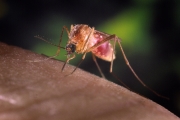August - West Nile Virus
 Margo Kerrigan, M.P.H, Area Director
Margo Kerrigan, M.P.H, Area Director
Indian Health Service California Area Office
West Nile Virus: Risk of Disease and Measures of Prevention

The Centers for Disease Control and Prevention (CDC) reports that more than 30,000 people in the United States have been reported with West Nile virus disease since 1999, and of those, almost 13,000 have been seriously ill and over 1,200 have died.* West Nile Virus (WNV) was first detected in the United States in 1999 and is most often spread by the bite of an infected mosquito. Mosquitoes become infected with the virus from feeding on infected birds and then transmit the virus to other animals and to humans when they bite.
The Centers for Disease Control and Prevention offers the following information related to clinical signs and symptoms of West Nile Virus:
- Approximately 1 in 5 people who are infected with West Nile virus will develop symptoms such as fever, headache, body aches, joint pains, vomiting, diarrhea, or rash.
- Less than 1 percent will develop a serious neurologic illness such as encephalitis or meningitis (inflammation of the brain or surrounding tissues).
- About 10 percent of people who develop neurologic infection due to West Nile virus will die. People over 50 years of age and those with certain medical conditions, such as cancer, diabetes, hypertension, kidney disease, and organ transplants, are at greater risk for serious illness.*
 There are no medications to treat or vaccines to prevent the West Nile Virus infection. Persons who have milder illness generally will recover without treatment; however may suffer with symptoms for several weeks. Others who have more severe illness may need to be hospitalized to receive supportive treatment such as intravenous fluids and pain medication.
There are no medications to treat or vaccines to prevent the West Nile Virus infection. Persons who have milder illness generally will recover without treatment; however may suffer with symptoms for several weeks. Others who have more severe illness may need to be hospitalized to receive supportive treatment such as intravenous fluids and pain medication.
Everyone who spends time outside is at risk of contracting West Nile; the more time spent outdoors, the higher the chance that you will be bitten by an infected mosquito. In addition, persons who are over 50 years of age are identified as being at higher risk for severe illness.*
Because of the potential seriousness of the disease and the fact that there are no vaccines to protect people from contracting the West Nile virus, we must rely on other means of protection. The CDC is working with state and local health departments and other government agencies, as well as private industry, to prepare for and prevent new cases of WNV. The CDC suggests that the best way to avoid West Nile Virus is to prevent mosquito bites and recommends taking the following precautionary measures:
- When outdoors, use insect repellent containing an EPA-registered active ingredient
 . Follow the directions on the package.
. Follow the directions on the package. - Dusk and dawn are times when mosquitoes tend to be most active so be sure to use insect repellent and wear long sleeves and pants at these times or consider staying indoors during these hours.
- Good screens on doors and windows help to prevent mosquitoes from entering your home.
- Get rid of mosquito breeding sites by emptying standing water from flower pots, buckets and barrels. Change the water in pet dishes and replace the water in bird baths weekly. Drill holes in tire swings so water drains out. Keep children's wading pools empty and on their sides when they aren't being used. *
*Content source: http://www.cdc.gov/ ![]()
Additional Resources for Information on West Nile Virus Disease and Prevention::
· CDC West Nile Virus Information: http://www.cdc.gov/westnile/resourcepages/index.html ![]()


 California Area Office
California Area Office